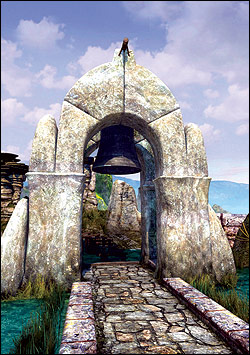Seattle downtowners and commuters of a certain age are encountering a kind of flash from the past on the sides of Metro buses: a poster bearing the sepia-tone image of a young female and swampy vegetation, and the words Myst 4: Revelation.
Myst? Myst 4? Shortly after issuing its first computer game for adults in 1993, a slow-paced, enigmatic computer exploration-game called Myst, obscure Spokane-based company Cyan became a worldwide electronic media magnet. There had been games emphasizing exploration before, and games rife with puzzles to be solved before the player could progress; there had been (very few) nonviolent adventure games. But there had never been a game quite as beautiful to look at as Myst. The world conjured up by Robyn and Rand Miller was both classically decorous and surreal to look at, an ominously gorgeous amalgam of De Chirico and Douanier Rousseau, awash in waves of ambient music and marvelously articulated natural sounds. Even as you banged your nose repeatedly against the game’s wily plotting, you were soothed and sustained by the look and sound of the world surrounding you. Despite the fact that many players never “finished” the game, over the ensuing decade it managed to sell 8 million copies.
In 1993, sales of 8 million would have seemed pretty spectacular. But over the 11 years since Myst, the video- and computer-game industry has experienced wave after wave of creative destruction; game “platforms” have proliferated, as faster and faster chip speeds and game engines have revolutionized the look and feel of games, putting a premium on sheer speed, noise, and dazzle. It was four years before Cyan was ready to issue a sequel to Myst, called Riven, and by that time the market was dominated by first-person “shooter” games demanding continuous 3-D animation, utterly out of sync with the Millers’ contemplative look and pacing. Riven was also, the company concedes, “the most mind-challenging” of Cyan products; in other words, damn hard to solve. Cyan remained a respected game-design company, but its visibility dimmed against the sheer racket of the competition.
It was another four years before the third “volume” of Myst emerged, and by 2001 it had become clear that a small, meticulous game company in the hinterlands couldn’t hope to maintain a market presence against world-spanning firms issuing dozens of games every year. Myst: Exile was created out of house by the design team responsible for the respected computer adventure The Journeyman Project. Cyan’s designers concentrated on recapturing the spotlight by creating a Myst-like multiplayer, real-time game to be played via the World Wide Web. Unfortunately, the numbers ultimately just didn’t add up, so the game ended up being released last year through conventional DVD channels as D’ni: Ages Beyond Myst.
Like Exile, this year’s Revelation incorporates some technical updates to enrich the game experience, most notably the player’s ability to rotate viewpoint throughout 360 degrees instead of the more staid screen-by-screen progression of the earlier incarnations. Also like Exile, an outside team created Revelation, this time a mostly francophone group working for the European game giant Ubisoft, which holds distribution rights to the entire Myst catalog.
The most surprising thing about Revelation on first encounter is how comfortably an old Myst maven slips into the groove. The new designers have caught the hallucinatory hyperclarity of the original games, and although they make full use of DVD storage ability, with elaborate animations of human figures and alien creatures, they keep the focus on the puzzle-driven main line of plot. If you felt a little cheated when Myst 1 left you hanging about the fate of the bad guys Cirrus and Achenar, Revelation promises at last to tell all to the clever and persistent player. And it has to be admitted that the player’s first encounter with Atrus, the quasi-god who supposedly creates these worlds by writing about them in a book, is frustrating enough that you can’t help wondering if the original bad guys didn’t have a point in trying to kick his ass.
If you, like me, sort of lost track of the Myst chronicles in the course of the 1990s, Ubisoft has made it seductively easy to pick up the thread where you left off: You can pick up a “10th anniversary” edition of the first three games for just $19.99, as well as the two D’ni “ages” for $29.99. The former, in particular, is a real bargain; in addition to the original games, you get built-in help and hint software to get you through those monitor-smashing moments the designers were so good at building into their toys. If you want to cut to the Revelation chase, it will set you back $39.99 list. All three packages require an up to date Mac or XP operating system, Pentium III and up, and all the latest sound-and-vision supporting software.









